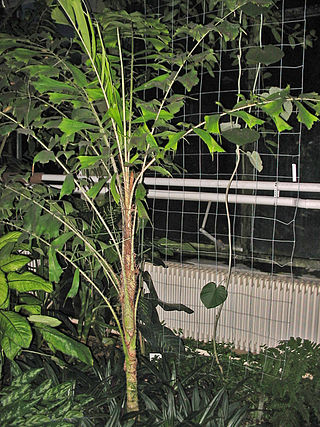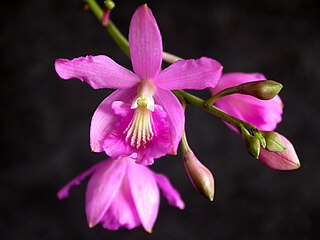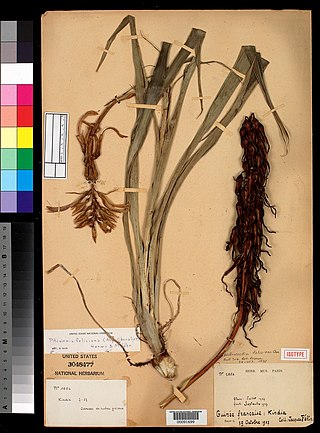
Orchids are plants that belong to the family Orchidaceae, a diverse and widespread group of flowering plants with blooms that are often colourful and fragrant. Orchids are cosmopolitan plants that are found in almost every habitat on Earth except glaciers. The world's richest diversity of orchid genera and species is found in the tropics.

Hoverflies, also called flower flies or syrphids, make up the insect family Syrphidae. As their common name suggests, they are often seen hovering or nectaring at flowers; the adults of many species feed mainly on nectar and pollen, while the larvae (maggots) eat a wide range of foods. In some species, the larvae are saprotrophs, eating decaying plant and animal matter in the soil or in ponds and streams. In other species, the larvae are insectivores and prey on aphids, thrips, and other plant-sucking insects.

Passiflora, known also as the passion flowers or passion vines, is a genus of about 550 species of flowering plants, the type genus of the family Passifloraceae.

Iridaceae is a family of plants in order Asparagales, taking its name from the irises. It has a nearly global distribution, with 69 accepted genera with a total of c. 2500 species. It includes a number of economically important cultivated plants, such as species of Freesia, Gladiolus, and Crocus, as well as the crop saffron.

Heliconia is a genus of flowering plants in the monotypic family Heliconiaceae. Most of the 194 known species are native to the tropical Americas, but a few are indigenous to certain islands of the western Pacific and Maluku in Indonesia. Many species of Heliconia are found in the tropical forests of these regions. Most species are listed as either vulnerable or data deficient by the IUCN Red List of threatened species. Several species are widely cultivated as ornamentals, and a few are naturalized in Florida, Gambia, and Thailand.

The longhorn beetles (Cerambycidae), also known as long-horned or longicorns, are a large family of beetles, with over 35,000 species described.

Buzz pollination or sonication is a technique used by some bees, such as solitary bees, to release pollen which is more or less firmly held by the anthers. The anthers of buzz-pollinated plant species are typically tubular, with an opening at only one end, and the pollen inside is smooth-grained and firmly attached. With self-fertile plants such as tomatoes, wind may be sufficient to shake loose the pollen through pores in the anther and accomplish pollination. Visits by bees may also shake loose some pollen, but more efficient pollination of those plants is accomplished by a few insect species who specialize in sonication or buzz pollination.

Clusia is the type genus of the plant family Clusiaceae. Comprising 300-400 species, it is native to the Neotropics. The genus is named by Carl Linnaeus in honor of the botanist Carolus Clusius.

Aiphanes is a genus of spiny palms which is native to tropical regions of South and Central America and the Caribbean. There are about 26 species in the genus, ranging in size from understorey shrubs with subterranean stems to subcanopy trees as tall as 20 metres (66 ft). Most have pinnately compound leaves ; one species has entire leaves. Stems, leaves and sometimes even the fruit are covered with spines. Plants flower repeatedly over the course of their lifespan and have separate male and female flowers, although these are borne together on the same inflorescence. Although records of pollinators are limited, most species appear to be pollinated by insects. The fruit are eaten by several birds and mammals, including at least two species of amazon parrots.

Zoophily, or zoogamy, is a form of pollination whereby pollen is transferred by animals, usually by invertebrates but in some cases vertebrates, particularly birds and bats, but also by other animals. Zoophilous species frequently have evolved mechanisms to make themselves more appealing to the particular type of pollinator, e.g. brightly colored or scented flowers, nectar, and appealing shapes and patterns. These plant-animal relationships are often mutually beneficial because of the food source provided in exchange for pollination.

Krameria is the only genus in the Krameriaceae family, of which any of the approximately 18 species are commonly known as rhatany, ratany or rattany. Rhatany is also the name given to krameria root, a botanical remedy consisting of the dried root of para rhatany or Peruvian rhatany.

Velloziaceae is a family of monocotyledonous flowering plants. The APG II system, of 2003, also recognizes this family, and assigns it to the order Pandanales.

Pseudolaelia is a small genus belonging to the orchid family (Orchidaceae), the entire genus endemic to Brazil. The abbreviation used in the horticultural trade is Pdla.

Attalea is a large genus of palms native to Mexico, the Caribbean, Central and South America. This pinnately-leaved, non-spiny genus includes both small palms lacking an aboveground stem and large trees. The genus has a complicated taxonomic history, and has often been split into four or five genera based on differences in the male flowers. Since the genera can only be distinguished on the basis of their male flowers, the existence of intermediate flower types and the existence of hybrids between different genera has been used as an argument for keeping them all in the same genus. This has been supported by recent molecular phylogenies.

Linderniaceae is a family of flowering plants in the order Lamiales, which consists of about 25 genera and 265 species occurring worldwide. Vandellia micrantha is eaten in Laos, but tastes bitter. Best known are the wishbone flowers Torenia fournieri and Torenia thouarsii, which are used as bedding plants, especially in the tropics. Micranthemum is sold as an aquarium plant when it is called 'baby tears'.

Pitcairnia feliciana is a plant endemic to central Guinea in West Africa and is the only species of bromeliad not native to the Americas. It can be found growing on sandstone outcrops (inselbergs) of the Fouta Djallon highlands in Middle Guinea.

Salvia is the largest genus of plants in the sage family Lamiaceae, with nearly 1000 species of shrubs, herbaceous perennials, and annuals. Within the Lamiaceae, Salvia is part of the tribe Mentheae within the subfamily Nepetoideae. One of several genera commonly referred to as sage, it includes two widely used herbs, Salvia officinalis and Salvia rosmarinus.

Dr Maarten Joost Maria Christenhusz is a Dutch botanist, natural historian and photographer.

Ameroglossum is a genus of Linderniaceae, containing the species Ameroglossum pernambucense endemic to the Borborema Plateau in Pernambuco, and Ameroglossum manoelfelixii found in Paraíba, in north-eastern Brazil. The species are only found on granitic rocky outcrops. The species are threatened by drought, fires, quarrying, trampling and cattle pasturing.
Catimbaua is a genus of shrubs in the family Linderniaceae. It contains a single species, Catimbaua pendula. It has pendant branches, greyish leaves and red flowers. The species occurs on steep cliffs in the Catimbau National Park in Pernambuco, north-eastern Brazil. It is closely related to Ameroglossum


















